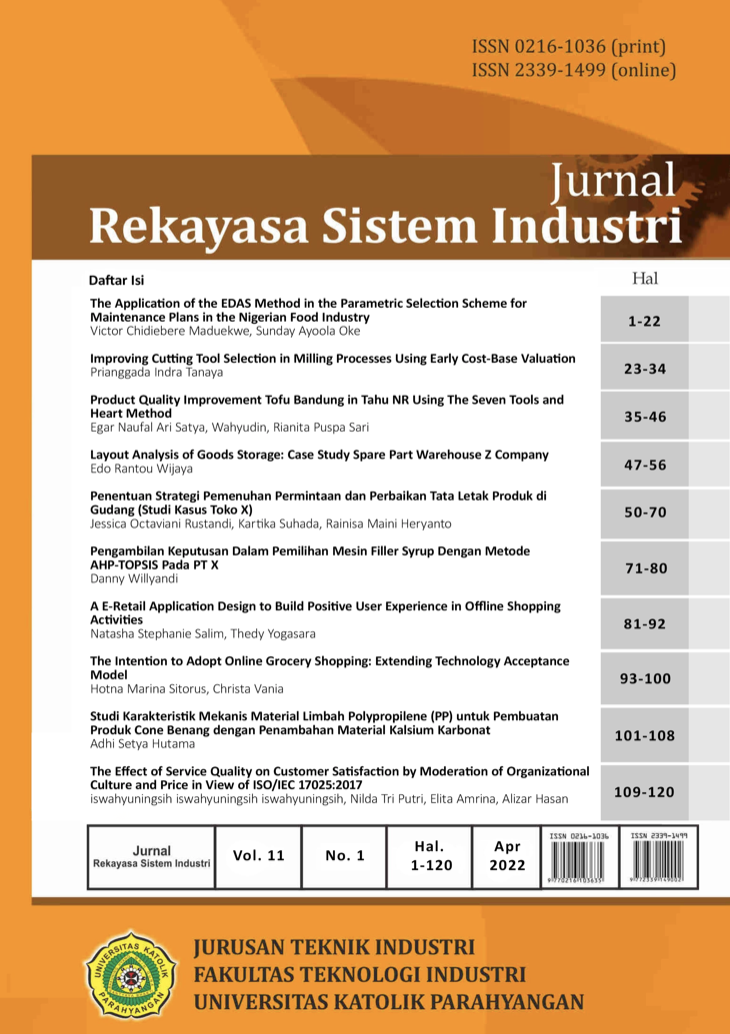E-Retail Application Design to Build Positive User Experience in Offline Shopping Activities
E-Retail Application Design to Build Positive User Experience
DOI:
https://doi.org/10.26593/jrsi.v11i1.5220.81-92Keywords:
offline shopping, HEART framework, usability, user experience, Web Semantics Design MethodAbstract
Shopping is a basic needs activity for humans in order to fulfil their needs. However, current technology development affect most of millenials shopping behavior and it becomes a challenge and an opportunity for offline stores retailers to offer easiness and quickness. This study aims to design an offline shopping app design that is expected to help consumers in having an easy, quick, and a new shopping experience. The initial design process is collecting a list of user needs regarding offline shopping activities at Yogya Department Store. Furthermore, the determination of mission statement, audience modelling, conceptual design, implementation design, and implementation is done according to Web Semantics Design Method. These stages produce 3 application design concepts, namely E-Store, V-Store, and E-Shop. Based on the assessment result of 4 respondents, the E-Store design concept got the highest score of 18,6 referring to the fulfillment of the user needs list. The E-Store design concept then developed into a high-fidelity prototype by adapting several features using Adobe XD. The evaluation was done by testing the usability and user experience of 12 participants. Participants were asked to do the task list and give an assessment with System Usability Scale and generate quantitative data with a score of 79 and qualitative data is obtained from participant responses. User experience testing was done by HEART framework and show an excellent result with a score above 70%. Subsequent improvements are made to each point that got a low score or a negative response along with suggestions from participants.
References
Armstrong, G., Kotler, P., & Opresnik, M.O. (2016). Marketing an Introduction–Global Edition (13th ed.). England: Pearson.
Badan Pusat Statistik, Sensus Penduduk 2020, Sensus Era Digital, [Online], Diakses dari: https://bandungkota.bps.go.id/news/2020/01/07/15/sensus-penduduk-2020--sensus-era-digital---.html [2020, 12 Desember].
Garnesia, I., Sana-sini Ngaku Milenial, Bagaimana Peta Milenial Indonesia?, [Online], Diakses dari: https://tirto.id/sana-sini-ngaku-milenial-bagaimana-peta-milenial-indonesia-cX5W [2018, 23 September].
Hassenzahl, M. (2008). User Experience (UX): Towards an Experiential Perspective on Product Quality. Proceedings of the 20th International Conference of the Association Francophone d'Interaction Homme-Machine on - IHM ‘08, Metz.
Kompas, Riset: Masyarakat Lebih Banyak Belanja Online Dibanding Offline, [Online], Diakses dari: https://money. kompas.com/read/2021/10/22/211000926/riset--masyarakat-lebih-banyak-belanja-online-dibanding-offline [2021, 25 Desember].
Lalwani, D. (2016). Young Consumers Online and Offline Channel Purchase Behaviour, MBA. Finland: Arcada University of Applied Sciences.
Lubis, M., Konsumen Indonesia Mulai Menyukai Belanja Online, [Online], Diakses dari: www.academia.edu/download/444352
/Purchasing_Behavior_in_Indonesia.docx [2018, 15 Agustus].
Piotrowicz, W. & Cuthbertson (2014). Introduction to The Special Issue Information Technology in Retail: Toward Omnichannel Retailing. International Journal of Electronic Commerce, 18(4), 5-16.
Rodden, K., Hutchinson, H., & Fu, X. (2010), Measuring the User Experience on a Large Scale: User-Centered Metrics for Web Applications. Proceedings of the 28th International Conference on Human Factors in Computing Systems.
Rubin, J. & Chisnell, D. (2008). Handbook of Usability: How to Plan, Design, and Conduct Effective Test. Indiana: Wiley Publishing, Inc.
SmarterHQ, Retail Marketing Strategies to Prioritize During COVID-19, [Online], Diakses dari: https://smarterhq.com/blog/ covid-retail-strategies [2021, 25 Desember]
Takashima, K., Brick-and-Mortar Retailers’ Survival Strategies Amid The COVID-19 Crisis [Online], Diakses dari: https://www.mitsui.com/mgssi/en/report/detail/__icsFiles/afieldfile/2020/07/21/2006o_takashima_e.pdf [2021, 25 Desember].
Troyer, O.D., Casteleyn, S., & Plessers, P. (2008). WSDM: Web Semantics Design Method di dalam Rossi, G., Pastor, O., Schwabe, D., & Olsina L, Web Engineering: Modelling and Implementing Web Applications, 303-351.
Verhoef, P. C., Kannan, P. K., & Inman, J. J. (2015). From Multi-Channel Retailing to Omni-Channel Retailing: Introduction to The Special Issue on Multi-Channel Retailing. Journal of Retailing, 91(2), 174-181.
Wenzl, M., Understanding Online Consumer Behaviors for a Better Customer Journey, [Online], Diakses dari: https://www.shipbob.com/blog/online-consumer-behavior/ [2021, 25 Desember].

